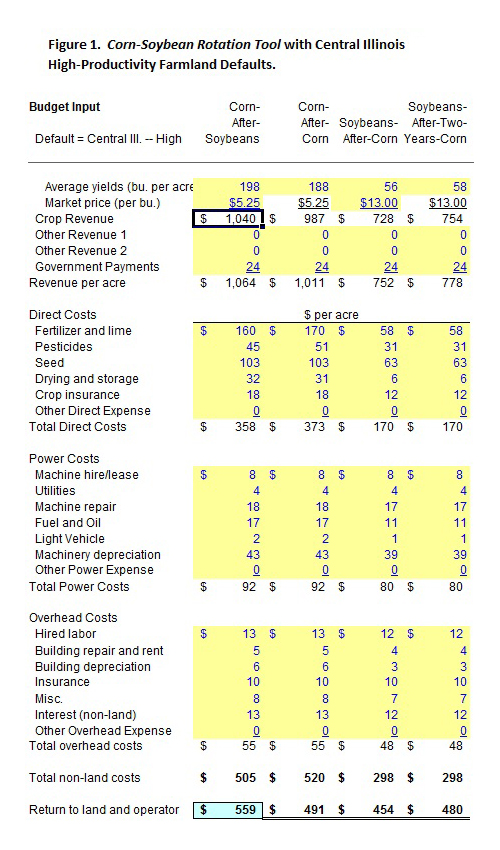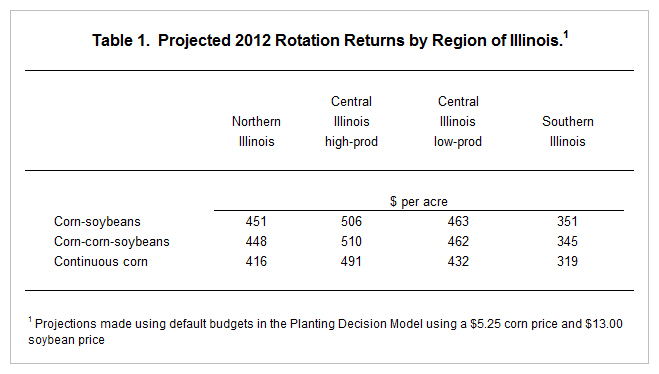Projected Corn-Soybean Returns Do Not Suggest Shift to Corn in Illinois: An Application of the Planting Decision Model
Returns projected using default budgets in the Corn-Soybeans Rotation Tool indicate that corn-soybean rotations have higher projected returns than continuous corn, given that commodity prices are at current harvest-time bids. These projected returns do not suggest shifts in acres from soybeans to corn in Illinois. In this article, the Corn-Soybean Rotation Tool used to make these projections is described. Then, commentary on 2012 planting decisions is given.
Planting Decision Model
The Corn-Soybean Rotation Tool is contained within the Planting Decision Model, a FAST spreadsheet available for download from the FAST section of farmdoc (www.farmdoc.illinois.edu/fasttools). The Planting Decision Model is a Microsoft Excel spreadsheet that runs on Windows based machines having Excel 2003 or higher. Besides the Corn-Soybean Rotation Tool, the Planting Decision Model includes tools that:
- Evaluate corn, soybean, and wheat rotations. This tool is useful for farms with wheat in their rotations, such as farms in southern Illinois.
- Estimates yields and returns by planting date. If planting is delayed, this information is useful for determining whether to switch from corn to soybeans.
- Estimates returns from taking prevented planting payments from crop insurance. When planting is delayed beyond final planting dates contained in crop insurance policies, this tool estimates returns from taking prevented planting or from planting a crop, thereby providing an return estimates when make prevented planting decisions.
- Estimates returns from replanting corn. If an uneven stand of corn has emerged after planting, this tool will estimate returns from replanting the damaged stand or keeping the damaged stand till harvest.
Corn-Soybean Rotation Tool

The layout of the Corn-Soybean Rotation Tool is shown in Figure 1. The tool contains corn-after-soybeans, corn-after-corn, soybeans-after-corn, and soybeans-after-two-years-corn budgets. Each budget contains defaults for yields, prices, and non-land costs. Users can modify these items. Also, default budgets are available for northern Illinois, central Illinois for farms with high-productivity farmland, central Illinois for farms with low-productivity farmland, and southern Illinois. Any time there is an Internet connection, these budgets can be updated with current values from the farmdoc website.
Figure 1 shows default budgets for central Illinois high-productivity farmland, with commodity prices modified to reflect current harvest-time bids. These budgets have corn and soybean prices of $5.25 and $13.00 per bushel, respectively. Yields are 198 bushels per acre for corn-after-soybeans, 188 bushels per acre for corn-after-corn, 56 bushels per acre for soybeans-after-corn, and 58 bushels per acre for soybeans-after-two-years-corn. Non-land costs are $505 per acre for corn-after-soybeans, $520 per acre for corn-after-corn, and $298 per acre for both soybean budgets. Operator and farmland returns then are:
- $559 per acre for corn-after-soybeans,
- $491 per acre for corn-after-corn,
- $454 per acre for soybeans-after-corn, and
- $480 per acre for soybeans-after-two-years-corn.
All corn budgets are projected to be more profitable than soybeans. However, planting all corn leads to all corn-after-corn in future years, which often has lower returns than rotations. As can be seen in the upper-right corner of Figure1, the Corn-Soybeans Rotation Tool reports calculates returns for three rotations:
- Corn-soybeans rotation which has a projected operator and land return of $506 per acre,
- Corn-corn-soybeans rotation which has a return of $510 per acre, and
- Continuous corn which has a return of $491 per acre.
Note that there is only a $4 per acre difference in returns from the corn-soybeans and corn-corn-soybeans rotations: $506 for corn-soybeans versus $510 for corn-corn-soybeans. Both rotations have higher returns than continuous corn.
Commentary on 2012 Planting Decisions

For high-productivity farmland in central Illinois, corn is projected to be more profitable than soybeans. However, planting all corn in 2012 could lead to lower returns in future years, as corn-after-corn has lower returns than rotations. More discussion of long-run rotation considerations is given here. Given these long-run considerations, it does not seem likely that central Illinois farmers will shift acres from soybeans to corn, particularly given substantial reductions in corn-after-corn yields relative to corn-after-soybeans yields that many farms experienced in recent years.
Central Illinois high-productivity farmland usually has returns that are more favorable to corn than other areas of the state. Table 1 shows rotation returns for northern Illinois, central Illinois with low productivities farmland, and southern Illinois. In all cases rotations have higher returns than continuous corn.
Summary
The Corn-Soybean Rotation Tool is used to make projections of 2012 crop returns. Projected returns suggest that rotations are more profitable than continuous corn, suggesting that there will not be a shift in acres to corn in Illinois.
Disclaimer: We request all readers, electronic media and others follow our citation guidelines when re-posting articles from farmdoc daily. Guidelines are available here. The farmdoc daily website falls under University of Illinois copyright and intellectual property rights. For a detailed statement, please see the University of Illinois Copyright Information and Policies here.







